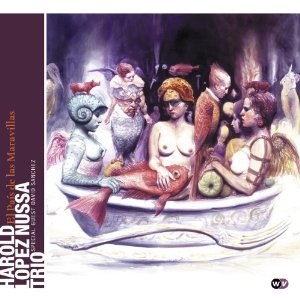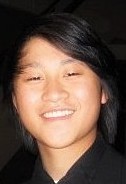 Harold Lopez-Nussa Trio Harold Lopez-Nussa is an up and coming Cuban pianist whose unique style has garnered international attention. As a winner at the Montreux Jazz Festival’s Solo Piano competition in 2005 and a visible figure on the European jazz scene, Lopez-Nussa asserts his own perspective on Afro-Cuban music. He is at the forefront of a fast growing trend of bridging the gap between the old and the new by adding a modern approach.
Harold Lopez-Nussa Trio Harold Lopez-Nussa is an up and coming Cuban pianist whose unique style has garnered international attention. As a winner at the Montreux Jazz Festival’s Solo Piano competition in 2005 and a visible figure on the European jazz scene, Lopez-Nussa asserts his own perspective on Afro-Cuban music. He is at the forefront of a fast growing trend of bridging the gap between the old and the new by adding a modern approach.
In his latest album release, El Pais de las Maravillas, he pushes all musical boundaries in pursuit of this new vision. His uncompromising, innovative compositions combined with spontaneous, percussive improvisation reflect a combination of notable iconic pianists like Chucho Valdes and Chick Corea.
El Pais de las Maravillas (Spanish for “The Wonderland”) is H. Lopez-Nussa’s second U.S. release. His trio includes his younger brother, drum prodigy Ruy Adrian Lopez-Nussa and bassist Felipe Cabrera. GRAMMY award-winning saxophonist David Sanchez joins the trio on selected tracks.
On this new album, H. Lopez-Nussa includes original compositions that cover both Afro-Cuban and contemporary styles like flamenco and clave.
The tune Guarija starts off the album with polyrhythmic flamenco that features a light piano melody over prominent drum work by Ruy Adrian Lopez-Nussa. Beginning with claps and whistles, this tune soon progresses into a conversation between the piano and drums. It later ends with a drum solo over a groove created by the piano and bass.
The next track features a different kind of conversation: one between Lopez-Nussa and saxophonist David Sanchez. Caminos begins with the piano and saxophone playing a unified melody which is interrupted when the rest of the trio enters. After establishing a groove, the melody comes back with Sanchez taking charge. After a riveting piano solo, the “conversation” goes back to Sanchez whose virtuous abilities add even more flavor to this tune. Besides Caminos, this saxophone/piano dialogue is found on both La Fiesta Va (a rhythmically driven tune with a dancing melody) and Bailando Suiza (a composition centered on a traditional clave groove). This leads into Volver, a dynamic piece that once again lets Sanchez take prominence by using the full range of his horn.
The album’s title track, El Pais de las Maravillas, begins with a piano solo that grows to become an orchestration with vocals floating over a lyrical melody. Living up to its English translation (The Wonderland), this piece is like a musical paradise with each layer peacefully coexisting to contribute to the overall theme.
LISTEN TO EXCLUSIVE STREAMING TRACKS FROM EL PAÍS DE LAS MARAVILLAS
Among a sea of rhythmically driven tunes, H. Lopez-Nussa also includes tracks that feature a more subtle, softer side of his piano playing. Both Perla Marina and A Camilin show off Harold’s diversity and spontaneity as a pianist. There are hints of his classical background during the solo at the beginning of Perla Marina. Building the melody off a central harmonic theme, he creates a beautiful atmosphere that is enhanced when the rest of the trio joins in. On A Camilin, bassist Felipe Cabrera shines as he languidly plays over the spaciousness created by the piano.
The only track on this album that keeps true to a traditional form of Afro-Cuban music is Pa’Gozar. It starts off with a duet between the piano and drums that later transforms into a montuno that acts as a transition into H. Lopez-Nussa’s solo. At the end, the piano comes back to the montuno and vocals are added that are an affirmation of his strong Cuban roots.
The remaining tracks on this album include E’cha and Amanecer. E’cha is a funky tune that shows off this trio’s dexterity. With the drummer steering the groove, this tune is like a strong current that never slows down or loses momentum. As for Amanecer, the pianist turns back to his gentle, more majestic side. R. A. Lopez-Nussa doubles on two instruments this time around, adding yet another unique voice to the trio with his contributions on the cajon and vibraphone. The tune ends with a five-second sixteenth note line that closes the album with confidence.
Overall, El Pais del las Maravillas is a brilliantly crafted album that confirms Harold Lopez Nussa’s rising popularity and recognition as a modern pianist. His passion for music is apparent in everything he plays. Whether it is playing solo, with his trio, or within a larger ensemble, Harold’s versatility is commendable and respectable. His powerful voice and innovative playing places him as a soon to be prominent figure in the jazz world.
Tracks: Guarija; Caminos; El Pais De Las Maravillas; La Fiesta Va; Perla Marina; Pa'Gozar; A Camilin; E'Cha; Bailando Suiza; Volver; Amanecer
Personnel: Harold Lopez-Nussa (piano), Felipe Cabrera (double bass), Ruy Adrian Lopez-Nussa (drums; Track 11 vibraphone & cajon), David Sanchez (saxophone on Tracks 2, 4, 9, 10).
 Ian Fong is a creative, passionate musician who thrives on exploring jazz with a new perspective. Born and raised in the San Francisco Bay Area, he was introduced to a variety of music at a young age. He started playing the alto saxophone when he was 9 years old and later switched to tenor saxophone 3 years later. It was not until 8th grade that he experienced a love for jazz. Auditioning and joining his school's jazz band, Ian began exploring the world of improvisation. His early and continuing influences include John Coltrane, Joshua Redman, Coleman Hawkins, Hank Mobley, Joe Lovano, and Wayne Shorter.
Ian Fong is a creative, passionate musician who thrives on exploring jazz with a new perspective. Born and raised in the San Francisco Bay Area, he was introduced to a variety of music at a young age. He started playing the alto saxophone when he was 9 years old and later switched to tenor saxophone 3 years later. It was not until 8th grade that he experienced a love for jazz. Auditioning and joining his school's jazz band, Ian began exploring the world of improvisation. His early and continuing influences include John Coltrane, Joshua Redman, Coleman Hawkins, Hank Mobley, Joe Lovano, and Wayne Shorter.
His blog is Jazz in Perspective.